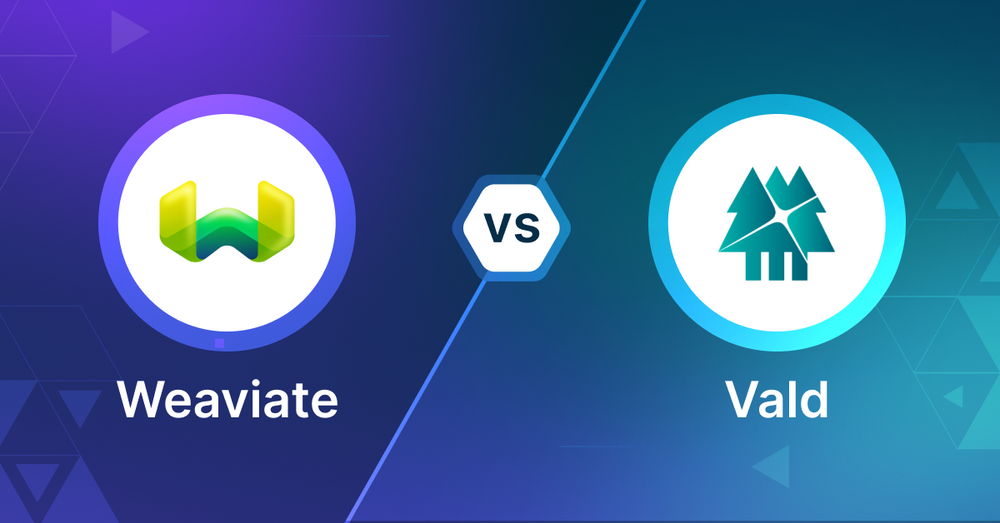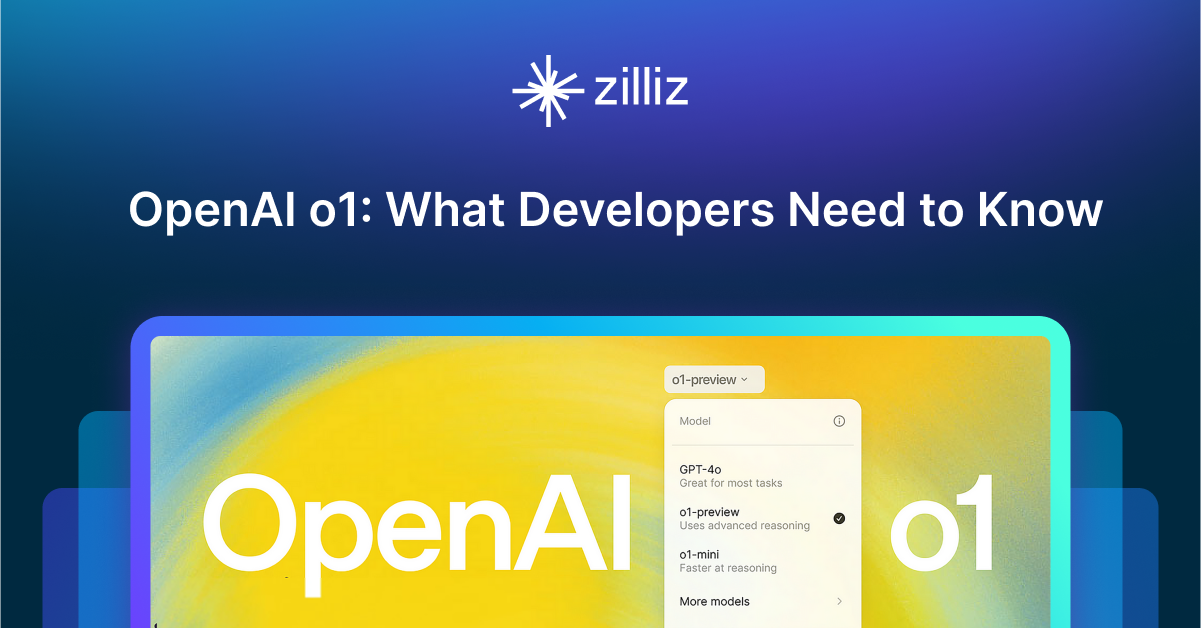Weaviate vs Vald: Choosing the Right Vector Database for Your Needs

As AI and data-driven technologies advance, selecting an appropriate vector database for your application is becoming increasingly important. Weaviate and Vald are two options in this space. This article compares these technologies to help you make an informed decision for your project.
What is a Vector Database?
Before we compare Weaviate and Vald, let's first explore the concept of vector databases.
A vector database is specifically designed to store and query high-dimensional vectors, which are numerical representations of unstructured data. These vectors encode complex information, such as the semantic meaning of text, the visual features of images, or product attributes. By enabling efficient similarity searches, vector databases play a pivotal role in AI applications, allowing for more advanced data analysis and retrieval.
Common use cases for vector databases include e-commerce product recommendations, content discovery platforms, anomaly detection in cybersecurity, medical image analysis, and natural language processing (NLP) tasks. They also play a crucial role in Retrieval Augmented Generation (RAG), a technique that enhances the performance of large language models (LLMs) by providing external knowledge to reduce issues like AI hallucinations.
There are many types of vector databases available in the market, including:
- Purpose-built vector databases such as Milvus, Zilliz Cloud (fully managed Milvus), and Weaviate
- Vector search libraries such as Faiss and Annoy.
- Lightweight vector databases such as Chroma and Milvus Lite.
- Traditional databases with vector search add-ons capable of performing small-scale vector searches.
Weaviate and Vald are both purpose-built vector databases. This post compares their vector search capabilities.
Weaviate: Overview and Core Technology
Weaviate is an open-source vector database designed to simplify AI application development. It offers built-in vector and hybrid search capabilities, easy integration with machine learning models, and a focus on data privacy. These features aim to help developers of various skill levels create, iterate, and scale AI applications more efficiently.
One of Weaviate's strengths is its fast and accurate similarity search. It uses HNSW (Hierarchical Navigable Small World) indexing to enable vector search on large datasets. Weaviate also supports combining vector searches with traditional filters, allowing for powerful hybrid queries that leverage both semantic similarity and specific data attributes.
Key features of Weaviate include:
- PQ compression for efficient storage and retrieval
- Hybrid search with an alpha parameter for tuning between BM25 and vector search
- Built-in plugins for embeddings and reranking, which ease development
Weaviate is an entry point for developers to try out vector search. It offers a developer-friendly approach with a simple setup and well-documented APIs. Deep integration with the GenAI ecosystem makes it suitable for small projects or proof-of-concept work. The target audience for Weaviate are software engineers building AI applications, data engineers working with large datasets and data scientists deploying machine learning models. Weaviate simplifies semantic search, recommendation systems, content classification and other AI features.
Weaviate is designed to scale horizontally so it can handle large datasets and high query loads by distributing data across multiple nodes in a cluster. It supports multi-modal data, works with various data types (text, images, audio, video) depending on the vectorization modules used. Weaviate provides both RESTful and GraphQL APIs for flexibility in how developers interact with the database.
However, for large-scale production environments, there are several considerations to keep in mind:
- Limited enterprise-grade security features
- Potential scalability challenges with multi-billion vector datasets
- Manual management required for newly released tiered storage options
- Horizontal scale-up requires assistance from Weaviate engineers and cannot be done automatically
This last point is particularly noteworthy, as it means organizations need to plan ahead and allocate time for scaling operations, ensuring they don't approach their system limits without proper preparation.
Vald: Overview and Core Technology
Vald is a powerful tool for searching through huge amounts of vector data really fast. It's built to handle billions of vectors and can easily grow as your needs get bigger. The cool thing about Vald is that it uses a super quick algorithm called NGT to find similar vectors.
One of Vald's best features is how it handles indexing. Usually, when you're building an index, everything has to stop. But Vald is smart - it spreads the index across different machines, so searches can keep happening even while the index is being updated. Plus, Vald automatically backs up your index data, so you don't have to worry about losing everything if something goes wrong.
Vald is great at fitting into different setups. You can customize how data goes in and out, making it work well with gRPC. It's also built to run smoothly in the cloud, so you can easily add more computing power or memory when you need it. Vald spreads your data across multiple machines, which helps it handle huge amounts of information.
Another neat trick Vald has is index replication. It stores copies of each index on different machines. This means if one machine has a problem, your searches can still work fine. Vald automatically balances these copies, so you don't have to worry about it. All of this makes Vald a solid choice for developers who need to search through tons of vector data quickly and reliably.
Key Differences
Search Methodology
Weaviate uses HNSW (Hierarchical Navigable Small World) for fast similarity searches. It supports hybrid queries, combining vector searches with filters. So you can search by semantic similarity and by specific data attributes.
Vald uses NGT (Neighborhood Graph and Tree) for fast approximate nearest neighbor searches. It can handle billions of vectors.
Data
Weaviate supports text, images, audio, video. Multi-modal data and flexible data modeling. You can define schemas for your data, so you can work with structured and semi-structured data.
Vald is focused on vector data. While it can handle a lot of vectors, it doesn’t support other data types or structured data like Weaviate does.
Scalability & Performance
Weaviate can scale horizontally by distributing data across multiple nodes in a cluster. But for very large datasets (multi-million vectors), some users have reported scaling issues. Scaling up requires Weaviate engineers and can’t be done automatically.
Vald is built for high scalability from the ground up. It can handle billions of vectors and scales with your needs. Vald uses distributed indexing so searches can continue even while the index is being updated.
Flexibility & Customization
Weaviate has good flexibility with GraphQL and RESTful APIs. It has various plugins for embeddings and reranking, so you can customize your search setup.
Vald allows data input and output customization, and works well with gRPC. It’s designed to fit into different setups and cloud environments.
Integration & Ecosystem
Weaviate has deep integration with the GenAI ecosystem so it’s suitable for AI applications, semantic search, recommendation systems and content classification.
Vald is designed to work in cloud environments and with gRPC but may not have as many integrations in the AI ecosystem as Weaviate.
Ease of Use
Weaviate is known for its developer friendly approach, simple setup and well documented APIs. It’s a good entry point for developers new to vector search.
Vald, while powerful, has a steeper learning curve since it’s focused on high performance, large scale vector search.
Cost
Both Weaviate and Vald are open-source, so the main costs will be infrastructure and maintenance. Weaviate has a managed service which can reduce operational costs but increase direct costs.
Vald can be more cost effective for very large datasets.
Security Features
Weaviate has some security features but not enterprise grade. It has authentication and access control but advanced security features are limited.
When to Choose Each
Weaviate is the better choice for projects that need a flexible vector database with strong AI ecosystem integration. It’s perfect for developers building AI applications, semantic search systems or recommendation engines when working with different data types like text, images and audio. Weaviate is great when you need to combine vector search with traditional database queries and want a easy to use solution for teams new to vector search.
Vald is the better option for projects with massive vector datasets, especially when scalability and search speed is key. It’s perfect for applications that need to handle billions of vectors like large scale similarity search in e-commerce, content recommendation for big platforms or real-time anomaly detection in huge datasets. Vald’s distributed architecture makes it a great choice for teams building high performance, cloud native applications that need robust vector search.
Summary
Weaviate is great for ease of use, flexibility with different data types and strong AI ecosystem integration. Vald is great for raw performance and scalability. Choose Weaviate if you need versatility and ease of integration, especially for smaller to medium size projects. Choose Vald if you need to handle massive vector datasets with high performance and scalability. Remember, the best choice depends on your project’s specific needs: data volume, search complexity and integration with existing systems.
While this article provides an overview of Weaviate and Vald, it's key to evaluate these databases based on your specific use case. One tool that can assist in this process is VectorDBBench, an open-source benchmarking tool designed for comparing vector database performance. Ultimately, thorough benchmarking with specific datasets and query patterns will be essential in making an informed decision between these two powerful, yet distinct, approaches to vector search in distributed database systems.
Using Open-source VectorDBBench to Evaluate and Compare Vector Databases on Your Own
VectorDBBench is an open-source benchmarking tool designed for users who require high-performance data storage and retrieval systems, particularly vector databases. This tool allows users to test and compare the performance of different vector database systems such as Milvus and Zilliz Cloud (the managed Milvus) using their own datasets and determine the most suitable one for their use cases. Using VectorDBBench, users can make informed decisions based on the actual vector database performance rather than relying on marketing claims or anecdotal evidence.
VectorDBBench is written in Python and licensed under the MIT open-source license, meaning anyone can freely use, modify, and distribute it. The tool is actively maintained by a community of developers committed to improving its features and performance.
Download VectorDBBench from its GitHub repository to reproduce our benchmark results or obtain performance results on your own datasets.
Take a quick look at the performance of mainstream vector databases on the VectorDBBench Leaderboard.
Read the following blogs to learn more about vector database evaluation.
Further Resources about VectorDB, GenAI, and ML
- What is a Vector Database?
- Weaviate: Overview and Core Technology
- Vald: Overview and Core Technology
- Key Differences
- When to Choose Each
- Summary
- Using Open-source VectorDBBench to Evaluate and Compare Vector Databases on Your Own
- Further Resources about VectorDB, GenAI, and ML
Content
Start Free, Scale Easily
Try the fully-managed vector database built for your GenAI applications.
Try Zilliz Cloud for FreeKeep Reading

OpenAI o1: What Developers Need to Know
In this article, we will talk about the o1 series from a developer's perspective, exploring how these models can be implemented for sophisticated use cases.

Vector Databases vs. Spatial Databases
Use a vector database for AI-powered similarity search; use a spatial database for geographic and geometric data analysis and querying.

Insights into LLM Security from the World’s Largest Red Team
We will discuss how the Gandalf project revealed LLMs' vulnerabilities to adversarial attacks. Additionally, we will address the role of vector databases in AI security.
The Definitive Guide to Choosing a Vector Database
Overwhelmed by all the options? Learn key features to look for & how to evaluate with your own data. Choose with confidence.